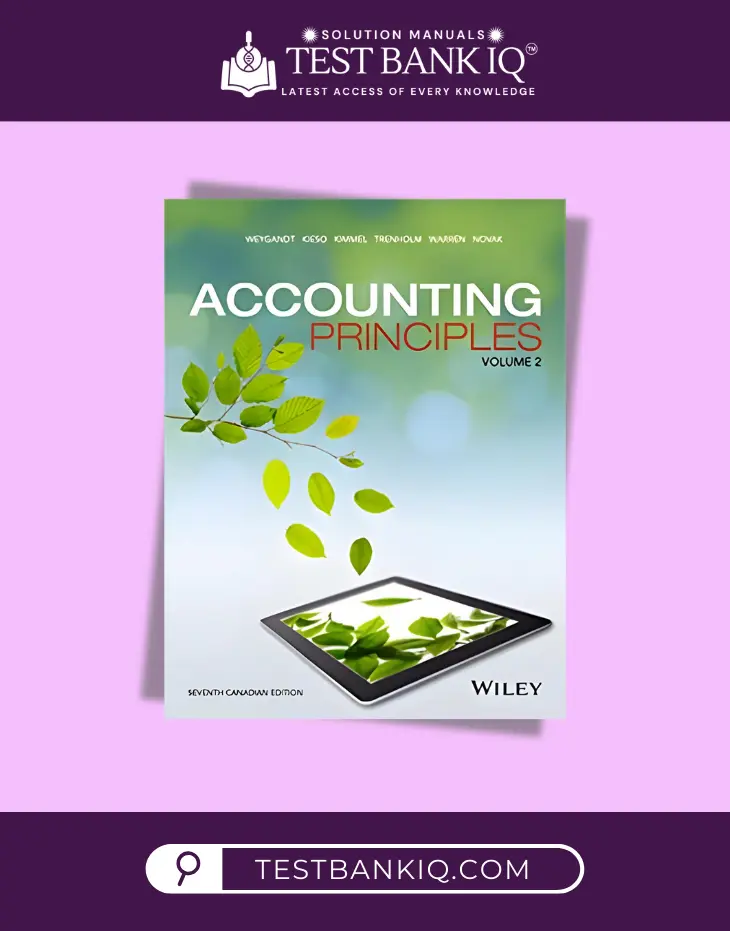Accounting Principles 7Th Canadian Edition Volume 2 By Jerry J. Weygandt
Table of Contents
- Title Page
- Copyright Page
- Dedication
- Brief Contents
- Contents
- Chapter 9 Long-Lived Assets
- Capitalizing on Education
- Property, Plant, and Equipment
- Determining the Cost of Property, Plant, and Equipment
- Depreciation
- Revising Periodic Depreciation
- Disposal of Property, Plant, and Equipment
- Natural Resources
- Cost
- Depletion
- Disposal
- Intangible Assets and Goodwill
- Accounting for Intangible Assets
- Intangible Assets with Finite Lives
- Intangible Assets with Indefinite Lives
- Goodwill
- Statement Presentation and Analysis
- Presentation
- Analysis
- Chapter 10 Current Liabilities and Payroll
- Butterflies Bring About Better Banknotes
- Determinable (Certain) Current Liabilities
- Accounts Payable
- Unearned Revenues
- Operating Line of Credit and Bank Overdraft
- Short-Term Notes Payable
- Sales Taxes
- Property Taxes
- Current Maturities of Long-Term Debt
- Uncertain Liabilities
- Provisions
- Contingencies
- Payroll
- Employee Payroll Costs
- Employer Payroll Costs
- Recording the Payroll
- Financial Statement Presentation
- Appendix 10A: Payroll Deductions
- Chapter 11 Financial Reporting Concepts
- The Need for Accounting Standards
- The Conceptual Framework of Accounting
- The Objective of Financial Reporting
- Elements of Financial Statements
- Qualitative Characteristics of Useful Financial Information
- Fundamental Characteristics
- Enhancing Qualitative Characteristics
- Application of the Qualitative Characteristics
- Differences in Qualitative Characteristics Under IFRS and ASPE
- Recognition and Measurement Criteria
- General Recognition
- Revenue Recognition
- Other Revenue Recognition Situations
- Expense Recognition
- Measurement of Elements
- Violation of Recognition and Measurement Concepts: Errors and Intentional Misstatements
- Foundational Concepts, Assumptions, and Constraints
- Concepts and Assumptions
- Constraints
- Summary of Conceptual Framework
- Looking Ahead
- Chapter 12 Accounting for Partnerships
- Partnering for Success
- Partnership Form of Organization
- Characteristics of Partnerships
- Advantages and Disadvantages of Partnerships
- Partnership Agreement
- Basic Partnership Accounting
- Forming a Partnership
- Dividing Partnership Profit or Loss
- Partnership Financial Statements
- Admission and Withdrawal of a Partner
- Admission of a Partner
- Withdrawal of a Partner
- Liquidation of a Partnership
- No Capital Deficiency
- Capital Deficiency
- Chapter 13 Introduction to Corporations
- The Advantages of Incorporation
- The Corporate Form of Organization
- Characteristics of a Corporation
- Operating a Corporation
- Share Capital
- Share Issue Considerations
- Common Shares
- Preferred Shares
- Retained Earnings
- Corporate Income Statements
- Cash Dividends
- Reporting Retained Earnings
- Statement Presentation and Analysis
- Presentation of Shareholders’ Equity
- Analysis
- Chapter 14 Corporations: Additional Topics and IFRS
- Brewing Shareholder Return
- Additional Share Transactions
- Stock Dividends and Stock Splits
- Reacquisition of Shares
- Comprehensive Income
- Continuing and Discontinued Operations
- Other Comprehensive Income
- Accounting Changes
- Changes in Accounting Estimates
- Changes in Accounting Policies
- Correction of Prior Period Errors
- Reporting Changes in Shareholders’ Equity
- Summary of Shareholders’ Equity Transactions
- Statement of Changes in Shareholders’ Equity
- Analyzing Shareholders’ Equity
- Earnings Performance
- Dividends Record
- Chapter 15 Non-Current Liabilities
- A New Lease on Aircraft Accounting
- Bonds Payable
- Types of Bonds
- Bond Issuance
- Bond Trading
- Bond Pricing
- Discount or Premium on Bonds
- Accounting for Bond Issues
- Issuing Bonds at Face Value
- Issuing Bonds at a Discount
- Issuing Bonds at a Premium
- Issuing Bonds at a Discount Versus at a Premium
- Bond Interest Accruals
- Accounting for Bond Retirements
- Redeeming Bonds at Maturity
- Redeeming Bonds Before Maturity
- Instalment Notes Payable
- Fixed Principal Payments
- Blended Payments
- Current and Non-Current Portions
- Lease Liabilities
- Operating Leases
- Finance Leases
- Statement Presentation and Analysis
- Presentation
- Analysis
- Chapter 16 Investments
- Growing an Agricultural Business through Strategic Investments
- Classifying Investments
- Non-Strategic Investments
- Strategic Investments
- Accounting for Debt Investments Reported at Amortized Cost
- Money-Market Instruments
- Bonds
- Accounting for Fair Value Investments
- Fair Value through Profit or Loss
- Fair Value through other Comprehensive Income
- Accounting for Strategic Investments
- Equity Method
- Cost Method
- Reporting of Investments
- Balance Sheet
- Income Statement and Statement of Comprehensive Income
- Summary of Investments
- Chapter 17 The Cash Flow Statement
- Going with the Cash Flow
- Reporting of Cash Flows
- Usefulness of the Cash Flow Statement
- Content of the Cash Flow Statement
- Preparation of the Cash Flow Statement
- Indirect Method
- Direct Method
- Using the Information in the Financial Statements
- Free Cash Flow
- Chapter 18 Financial Statement Analysis
- Corus Entertains Investors
- Basics of Financial Statement Analysis
- Comparative Analysis
- Tools of Analysis
- Horizontal Analysis
- Balance Sheet
- Income Statement
- Vertical Analysis
- Balance Sheet
- Income Statement
- Ratio Analysis
- Liquidity Ratios
- Solvency Ratios
- Profitability Ratios
- Limitations of Financial Statement Analysis
- Alternative Accounting Policies
- Comprehensive Income
- Quality of Information
- Economic Factors
- Appendix A: Specimen Financial Statements
- Appendix B: Sales Taxes
- Appendix PV: Present Value Concepts
- Company Index
- Subject Index
- EULA


















There are no reviews yet.